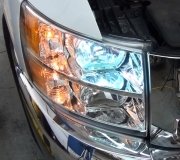The only thing that can cause too much current to flow through the switch is something has been added to the circuit such as aftermarket fog lights. While the switches do fail on occasion, it's more common for the terminals in the connector to overheat. Once that happens, the overheated connector develops high resistance which causes more heat to build up. The only plastic that can burn and smell, (thank you for including that observation), is the connector body holding all the wires. The switch itself is bakelight and metal. You won't smell those.
Look at the rivets holding the terminals to your old switch. You will likely see one or two of them are black and loose, and the there's a bunch of crumbling carbon around it. Now look at the corresponding terminals in the connector. You will see it too is black and the plastic body is melted.
You don't have to replace the entire connector. You DO have to chisel out all the burned plastic because that carbon, which is a result of something burning, will allow current to flow through it causing more damage. I use a dremel tool to clean it up. Cut off the overheated wire back far enough to find clean flexible copper to solder to. The overheated part of the wire will be stiff and hard to bend. You also will not be able to solder to it properly. Solder on a piece of the same size wire, usually about 4 inches worth, then solder on a terminal that can plug into the switch. You can use crimp-style terminals, but solder it to the wire. This is no place to rely on a crimp in a high-current circuit.
If you are emotionally involved with the connector, you can snip one out of a car in the salvage yard, then transfer the wires one at a time. It really isn't necessary though. The connector body is just a convenience so you don't have to plug in each wire one by one, and you won't mix them up. When you replace just the one or two terminals individually, check that they are tight when installed onto the switch. If one feels loose, unplug it and squeeze it with a pliers to make it fit snugly on the switch. If it's loose, there will be poor contact and the high current will start the overheating problem all over again.
Those terminals have to pass roughly ten amps for a pair of low beam head lights; slightly more for a pair of high beams, and about an amp a piece for the running and tail lights. Aftermarket fog lamps will add another 15 amps which definitely will stress the switch. For that reason, factory fog lamps are run with a relay, and the headlight switch just turns on the relay. That adds almost nothing to the load on the switch. Most aftermarket fog lamp kits include a relay too to prevent overloading problems.
Caradiodoc
Wednesday, December 2nd, 2009 AT 3:06 AM


